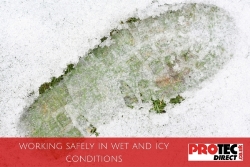During the winter season, the temperature drops, the nights draw in and there is more rainfall. As well as this, leaves fall from the trees, water freezes and snow can build up on paths. All of these factors can make any kind of moving around dangerous, especially if you’re working outside.
There are several major issues to contend with during the winter months according to the Health and Safety Executive, including inclement weather like storms, lightning and heavy rain.
While storms and lightning may be significant dangers in their own right, your chances of being affected are low. However, rainfall can be the cause of many work related injuries and even deaths. Rain causes surfaces to become slippery, so roads, pavements and work environments are instantly more dangerous.
When you combine this with decaying matter such as leaves, it can prove to be even more of a hazard. If leaves on the track can stop a train, just imagine what they can do to you or your vehicle.
How to Keep Your Employees Safe
In order to combat the effects of slippery conditions, you should ensure that all employees are given appropriate personal protective clothing (PPE), specifically footwear so that slipping risks are reduced. You should discourage people from taking shortcuts over grass or dirt, which can be extra slippery when wet. Think about your walkways and access routes and assess whether they are safe to pass, and if possible, construct a canopy to prevent surfaces being affected by water.
Of course, another major hazard in winter is ice. This is not always as visible as rainwater, and potentially more dangerous as it can appear anywhere. You need to identify areas that are at risk from ice and snow, such as entranceways, stairs and sloped areas. Appropriate signage can draw people’s attention to the danger and gritting overnight can help to prevent the build up of ice.
It is always best not to work outside in icy conditions, if at all possible. Unless it can be absolutely avoided it is not safe to do so. If you have to work in these difficult conditions, ensure you let someone know where you will be and wear the correct PPE. This also includes keeping warm so that you don’t suffer the effects of extreme cold.
Monitor temperatures before and during the job so that you are aware if things are getting worse. The night before a job, it’s also a good idea to assess weather conditions so that you can make other plans if necessary. Driving in icy conditions is particularly dangerous and is not advised. Although modern cars are well equipped to hold the road, ice is always a danger to you and others on the roads. Only absolutely essential journeys should be made in these conditions.
The British winter poses some threats to working conditions but with good planning and common sense, these can be easily managed so that you can stay safe.





Leave a comment